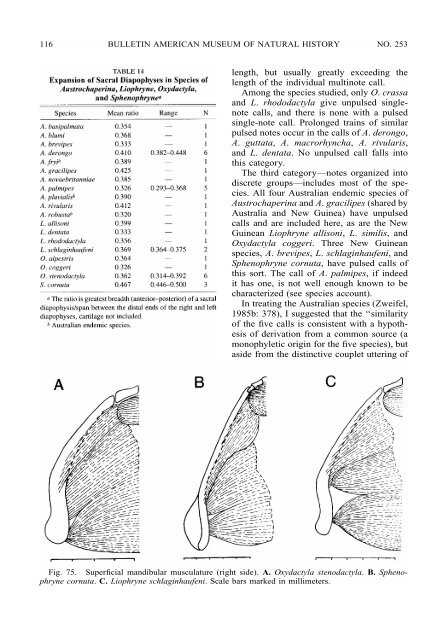SPHENOPHRYNE - American Museum of Natural History
SPHENOPHRYNE - American Museum of Natural History
SPHENOPHRYNE - American Museum of Natural History
Create successful ePaper yourself
Turn your PDF publications into a flip-book with our unique Google optimized e-Paper software.
116 BULLETIN AMERICAN MUSEUM OF NATURAL HISTORY NO. 253<br />
length, but usually greatly exceeding the<br />
length <strong>of</strong> the individual multinote call.<br />
Among the species studied, only O. crassa<br />
and L. rhododactyla give unpulsed singlenote<br />
calls, and there is none with a pulsed<br />
single-note call. Prolonged trains <strong>of</strong> similar<br />
pulsed notes occur in the calls <strong>of</strong> A. derongo,<br />
A. guttata, A. macrorhyncha, A. rivularis,<br />
and L. dentata. No unpulsed call falls into<br />
this category.<br />
The third category—notes organized into<br />
discrete groups—includes most <strong>of</strong> the species.<br />
All four Australian endemic species <strong>of</strong><br />
Austrochaperina and A. gracilipes (shared by<br />
Australia and New Guinea) have unpulsed<br />
calls and are included here, as are the New<br />
Guinean Liophryne allisoni, L. similis, and<br />
Oxydactyla coggeri. Three New Guinean<br />
species, A. brevipes, L. schlaginhaufeni, and<br />
Sphenophryne cornuta, have pulsed calls <strong>of</strong><br />
this sort. The call <strong>of</strong> A. palmipes, if indeed<br />
it has one, is not well enough known to be<br />
characterized (see species account).<br />
In treating the Australian species (Zweifel,<br />
1985b: 378), I suggested that the ‘‘similarity<br />
<strong>of</strong> the five calls is consistent with a hypothesis<br />
<strong>of</strong> derivation from a common source (a<br />
monophyletic origin for the five species), but<br />
aside from the distinctive couplet uttering <strong>of</strong><br />
Fig. 75. Superficial mandibular musculature (right side). A. Oxydactyla stenodactyla. B. Sphenophryne<br />
cornuta. C. Liophryne schlaginhaufeni. Scale bars marked in millimeters.
















